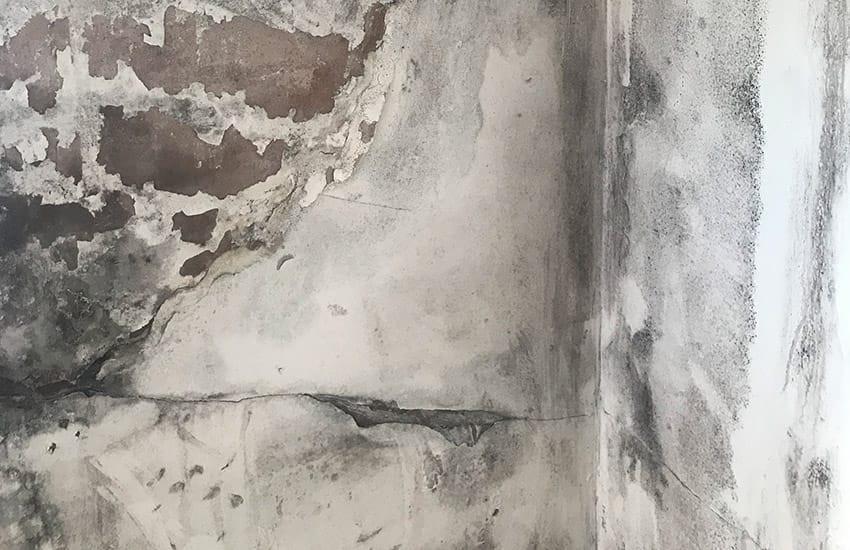
Call our team
01484 442420Find An Applicator
Menu
close

Fortunately, there are solutions. In this post, we’ll look at the different types of damp to help you identify what you’re dealing with then discuss how to stop damp coming through your walls, up your walls and appearing on your walls!
Damp walls are potentially more serious than you think. Aside from causing unsightly damp patches, the moisture can eventually damage your walls’ structural integrity if it’s left unresolved.
Damp walls also provide the perfect environment for mould to develop, which can trigger respiratory problems like asthma as well as increasing the chance that they will develop in the first place.
So where is it coming from? Damp walls typically arise because of one of three root causes…
Rising damp occurs when water in the ground under your walls rises through the wall itself. This happens through capillary action, with water absorbed through small openings in the building materials. In this case, the damp will be coming up your walls. You’ll usually be able to see a tide mark where the water stops, up to a metre above the ground.
On the flipside, the moisture could be coming from above. Leaks in your roof or guttering can allow water to make its way into internal walls, leading to damp patches. Alternatively, the leak could wear down the external pointing, leading to water ingress over time. If you’re wondering how to stop damp coming through walls, specifically, then this type of water ingress is probably the cause.
The final and possibly most common cause of damp is moisture within your home. Moisture is naturally released by activities like washing, cooking and even breathing. If the moisture has nowhere to go, it could be absorbed by your walls. That’s especially true if they’re cold, with moisture naturally drawn to colder surfaces. Rather than coming through your walls, this damp will appear on your walls because of internal moisture.
To stop damp walls, first and foremost, you’ll need to tackle the root cause. If the damp is coming from moisture in your home, ventilation is the first port of call. Allow moisture out by opening a window when you’re showering or cooking, for instance. It’s also best to keep your home at a comfortable temperature, above 18°C, so there aren’t any places where moisture can gather.
That said, it’s not always possible to heat every inch of your home while also letting out every drop of moisture. That’s where damp-proof walls can help. Coating your walls with CorkSol SprayCork can stop moisture gathering on them, as it’s naturally moisture-resistant.
Drawing on the natural properties of cork, the coating can also improve your home’s insulation. An insulative layer on the inside of your walls will make it easier to keep the temperature up without having to crank up the heating.
Read a recent case study to find out how CorkSol SprayCork provided a long-lasting, effective solution to a severe damp problem in a 1960’s London Tower Block.
If damp is coming through your walls from the outside, an external cause will be at play.
This could be as simple as a broken gutter or downpipe, allowing water to run down your wall rather than guiding it into your drains. Over time, it will wear away the pointing and water will pass through your wall. This is arguably the best cause of damp as it’s so straightforward to fix. Get your gutters repaired, repoint the walls and your damp issue should be solved.
On the other hand, pointing could have broken down without a specific fault. This is particularly common for homes in areas with wind-driven rain. Rain with a horizontal velocity is prevalent along the west coast of the UK – West Wales, West Scotland and the North-West and South-West of England. It can soak brickwork, wear down pointing or wall coverings and make damp come through your walls.
You could get your walls repointed, but this won’t stop the problem for good. A weather-resistant coating is a long-lasting alternative which will protect your brickwork from the elements. SprayCork is extremely weather resistant, backed by a 25-year guarantee.
The cork-based coating also has no chemical reaction with salt, which is another potential cause of damp coming through walls for coastal properties. In this case, salty sea air can erode materials like render, leaving walls more exposed to the elements. Salt-resistant SprayCork ensures that you won’t have a nasty damp surprise inside your home.
Last but not least, there’s rising damp. In this case, a new damp-proof course will need to be installed. SprayCork can be used as a water-repellent layer in your brickwork to stop damp in its tracks as it rises up your walls. As with other applications, it’s impressively long-lasting, so you don’t have to worry about recurring problems or continual maintenance.
If you want to stop damp coming through walls in your home or commercial property, Corksol is ready and waiting. Our innovative CorkSol SprayCork coating provides an effective solution to eliminate damp walls and make your property more comfortable. It can be used to combat condensation damp, penetrative damp and even rising damp with great results every time.
Want to find out more? Contact our team today or find your nearest approved applicator, who is fully trained and equipped to stop damp coming through your walls with the power of CorkSol SprayCork.
"*" indicates required fields